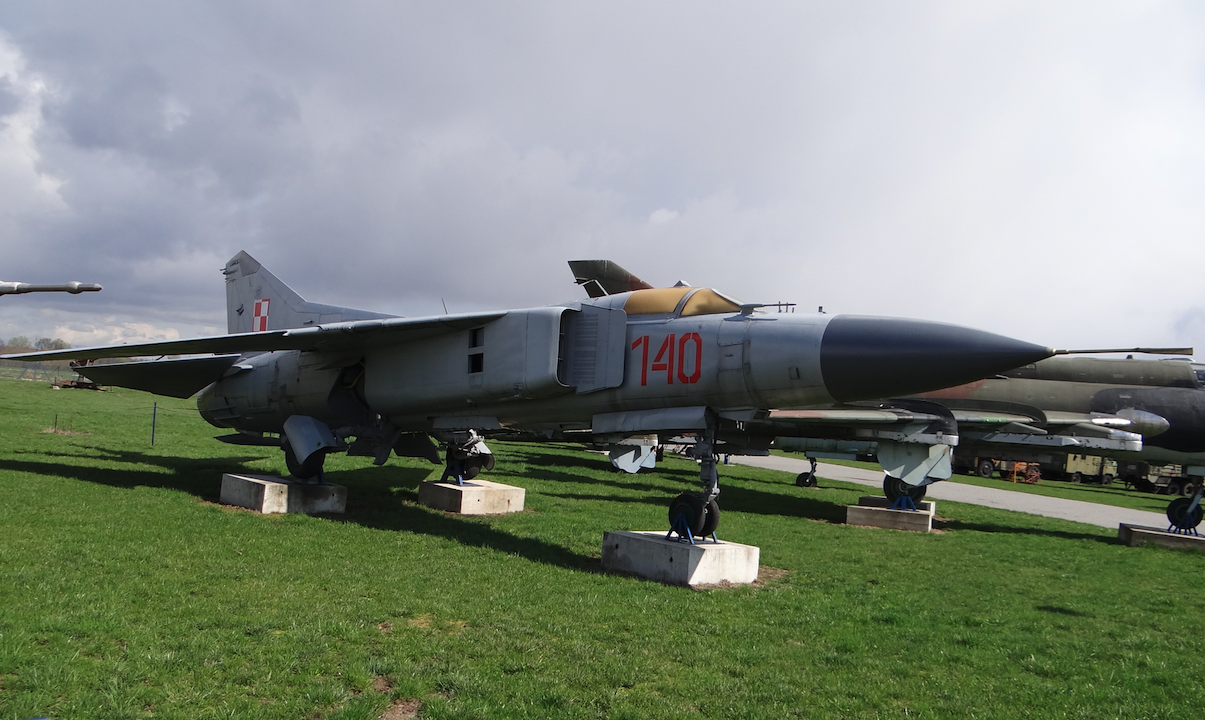Kraków 2007-01-02
255 Section 1979-06-04
OKB Mikojan and Guriewicz MiG-23 MB, UB. Poland
Fighter aircraft with variable wing geometry.
History
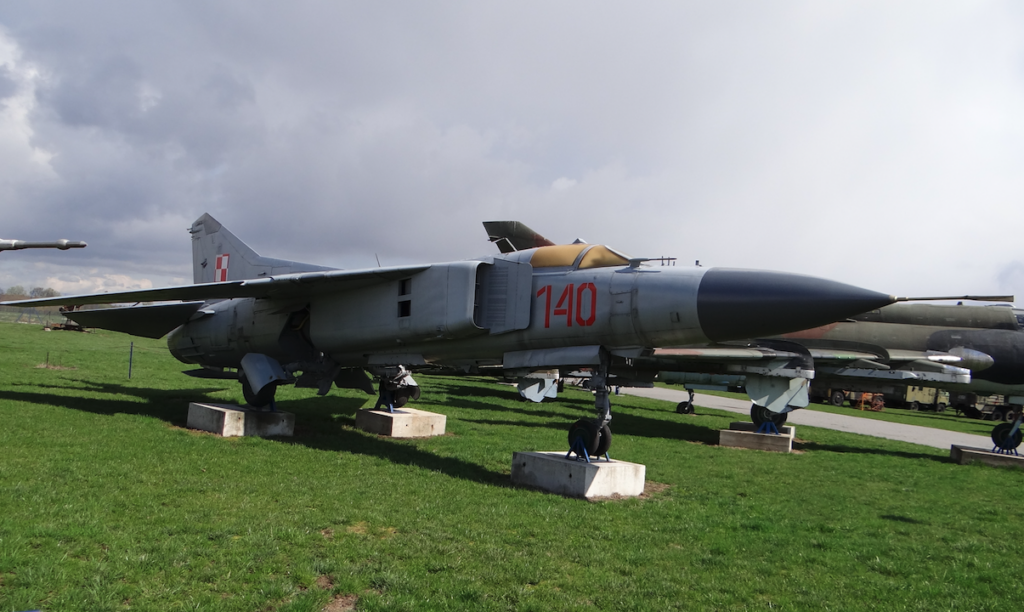
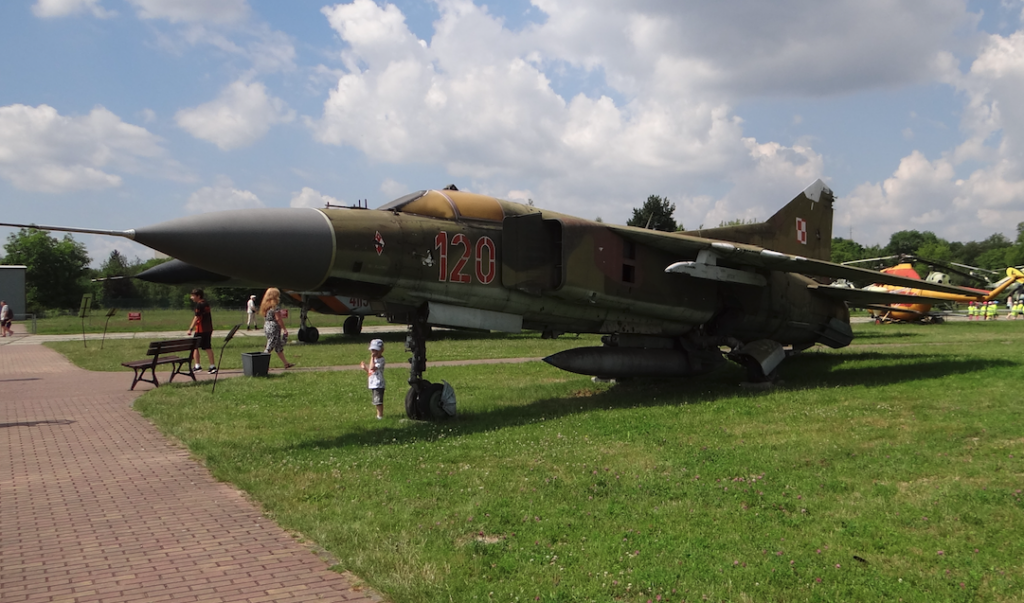
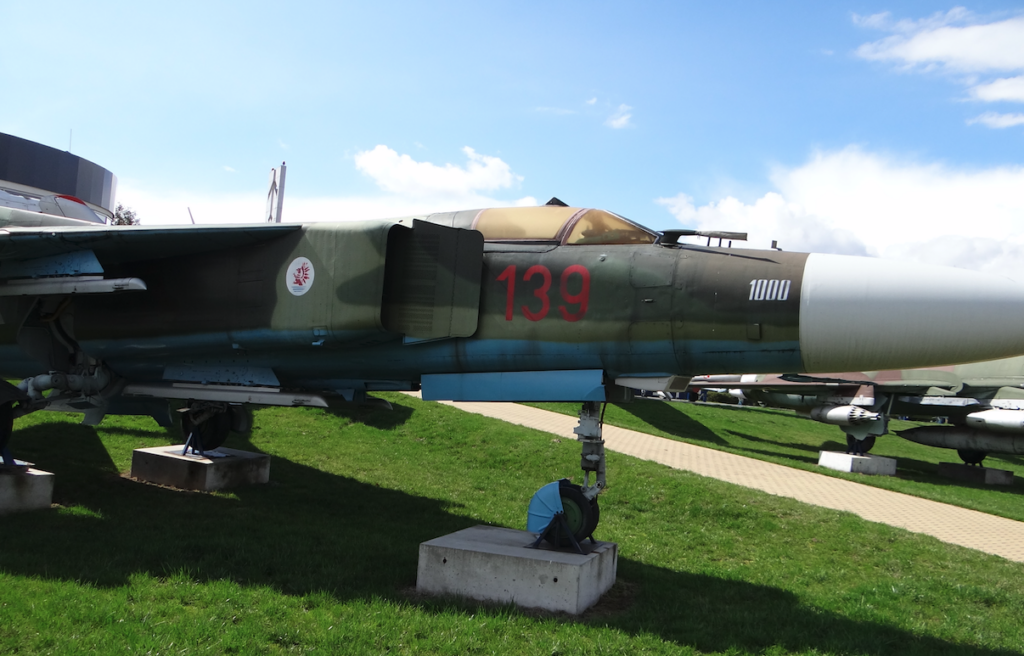
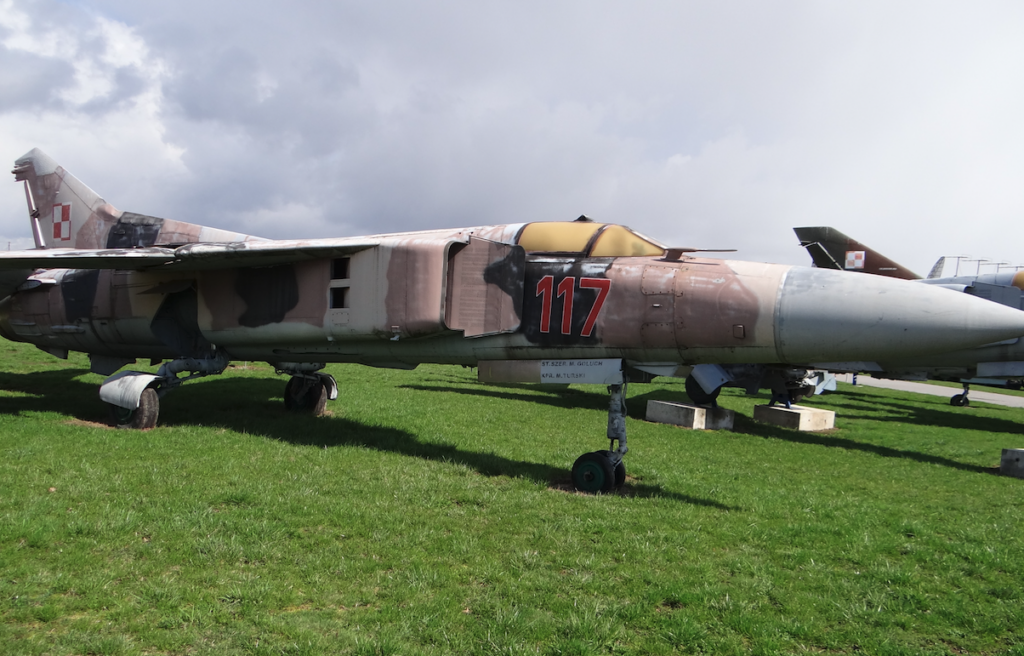
Before we discuss the MiG-23 fighter, which was armed with the Polish Army, let’s look at the versions created in CCCP.
MiG-23 M. 1972 year.
In parallel with the work on the MiG-23 UB two-seater, works were carried out to improve the one-seater MiG-23 S. The changes concerned many basic solutions. The aircraft received a new powerplant, lighter and with greater thrust, the Khachaturov R-29-300 engine, known as the Tumanski R-29, with 81.34 kN thrust, and 120-130 kN afterburning. This change resulted in the need to enlarge the grips and air ducts.
Movable parts of the wings were subjected to a major modification. A surface with a characteristic step was added before the leading edge. This surface caused a change in the convergence of the lobes, and thus the angle of the leading edge changed by 2 degrees and 40 minutes. At that time, four-segment movable flaps at the leading edge were not yet installed. They appeared during production after 1973.
The enlargement of the wing surface and the change in the center of gravity of the aircraft was compensated by moving the wings forward by 0.60 m. The introduced changes resulted in a decrease in the stability reserve compensated by the AP-155 system, and thus an increase in maneuverability. Due to the engine change, the rear hull has been shortened. Aerodynamic brakes have been redesigned, enlarging and swinging more in working position.
The change of engine coincided with the refinement of the final version of the avionics equipment. The machine was given the designation MiG-23 M and 23-11 M. aircraft. The plane received a new S-23 D aiming system, which includes the Szafir-23 D radar station, with a range of 55 km and 35 km in target tracking, with the possibility of detection on the background of the earth and in the rear hemisphere. TP-23 thermal indicator and ASP-23 D optical sight. Lazur-SM command guidance system (ARL-SM). AWM-23 analogue calculating machine. Delta-NG command guidance station in the beam under the right air grip. Automatic system SAU-23 A s 2. Navigation system Poliot-1 I-23 consisting of; RSBN-6 S, course and riser layout SKW-2 N 2, DW-30 and DW-10 air signal relays. In addition, the aircraft received; ARK-15 radio compass, RW-4 radio altimeter.
The armament of the aircraft is the GSz-23 L cannon. Guided missiles; k.p.r. H-66, R-23 R, R-23 T, R-13 M, R-3 S, R-60. Non-guided missiles S-5, S-8, S-24 and 50-500 kg bombs.
The MiG-23 M prototype was flown in June 1972 by A. W. Fiedotow.
MiG-23 MS (1974 year), MiG-23 MF (1978 year) – Airplane MiG-23 M export variants.
Planes differ in equipment;
MiG-23 MS is a combination of the airframe and engine of the MiG-23 M aircraft with the armament system of the MiG-23 S. aircraft. These aircraft have been exported to the Middle East since 1974.
MiG-23 MF (forsitowannyj) is a slightly modified MiG-23 M, exported since 1978, to the Warsaw Pact countries, and then to other selected recipients. These aircraft were equipped with devices; ARL-SMA, S-23 E (RPSN-323 E), ARK-15 M, SO-69, RI-65, TP-23-1, Pion-N antenna system integrated to cooperate with RSBN-6. In addition, pressure refueling of the machine was enabled.
MiG-23 in Poland. 1979 year.
For the first time with the MiG-23 aircraft, our politicians and military officers came across while looking for a successor to the IL-28 bomber aircraft. The last six bombers were removed from the state in 1979, but in fact for the entire decade they were no longer of any combat value. CCCP offered us MiG-23 BN or Su-20 aircraft. Both aircraft with variable wing geometry. According to Polish specialists, none of the aircraft offered did not meet our requirements, but there was no other alternative. The choice fell on the Su-20 as a cheaper machine similar to the Su-7 aircraft we have used so far.
The search for a new aircraft for WOPK was similarly difficult. Our Eastern partner (then it was necessary to speak – brother country) offered us a MiG-23 MS plane. This offer was unsatisfactory for Poland. They were aircraft with weapons from the MiG-21 bis. They had no way of attacking at a meeting course. In addition, problems with the operation of these machines effectively discouraged the Polish side from this investment. Offering the export version of the MiG-23 M aircraft was constantly shifted in time.
The MiG-23 MS aircraft was equipped with newer avionics and a large number of structural defects removed. The resulting version was called MiG-23 MF and was offered to the Polish side. This time in May 1978, the proposal was approved and accepted.
At the same time, a decision was made to train the first group of pilots and technicians for a new type of fighter. The first of the three planned airborne regiments was 28 PLM stationed in Słupsk. However, before a group of Polish officers was selected for training in CCCP, the unit’s staff from Słupsk, using the invitation of the Soviet 871 PLM, which was stationed in Poland in Bagicz near Kołobrzeg, got to know the aircraft and its capabilities. Soviet pilots presented the MiG-23 M aircraft in flight, and technicians had the opportunity to familiarize themselves with the airframe and its operation.
Opinions of Polish officers were different. On the one hand, there was talk of high machine failure rate and complicated service. However, positive reviews prevailed. Much attention was paid to the variable geometry of the wings, which until now could only be seen in Powidz, where in 1976 the conversion to the Su-20 fighter-bomber was completed. Good take-off and landing parameters, high altitude and high maximum speed of the MiG-23 M aircraft were optimistic.
On 29.01.1979, a group of 13 pilots from the 28th PLM and technicians, under the command of lieutenant colonel pilot Janusz Dorżyński went on a three-month training to Ługawoje in CCCP. The following pilots participated in this training: Lt. Col. pil. Janusz Dorżyński, lieutenant colonel pil. Waldemar Piegza, Major Pil. Bogdan Sokołowski, Major Pil. Mieczysław Walentynowicz, Capt. pil. Andrzej Jasiński, Capt. pil. Tadeusz Potaczała, Capt. pil. Zbigniew Różalski, Capt. pil. Stanisław Szafruga, cf. pil. Jerzy Bekus, cf. pil. Ryszard Drzymała, cf. pil. Marian Krzemiński, cf. pil. Janusz Rybicki, lieutenant pilgrim Czesław Zabiełło (he did not finish the training).
The pilots underwent a two-month theoretical training ended with an exam, after which they sat at the controls of the Soviet MiG-23 M / MS / MF / UB. The first flights showed good flight properties. Rapid acceleration of the machine has been confirmed. The engine quickly and eagerly entered the revs. The plane was easy to fly. The performance and equipment of the MiG-23 did not resemble the fighters used so far in Poland. We mean MiG-21 up to and including the MF version. The MiG-23 was supposed to completely displace MiG-21 fighters from the first line.
On April 28, 1979, after passing the final exams, all staff returned to Poland. At that time, the airport in Słupsk was closed because it was subjected to significant modernization. The runway and taxiways have been strengthened. All equipment of the unit was transferred to Zegrze Pomorskie, where training continued. Also in 1979, the transfer of some of the previously operated MiG-21 MF and MiG-21 UM aircraft to other regiments began.
Unfortunately, despite the efforts, the modernization in Słupsk was not completed until the arrival of the first MiG-23 machines. Therefore, it was decided that the planes would be accepted at the airport in Minsk Mazowiecki.
A month before the date of delivery of the first batch of MiG-23 aircraft, a group of pilots and technicians from the 28th PLM went to Minsk Mazowiecki to collect aircraft from the Soviet side.
We received the first MiG-23 MF / UB aircraft on June 4, 1979, 11 copies: MiG-23 MF nb 120, 121, 122, 139, 140, 141, 145, 146, 147, 9 items in total, MiG- 23 UB nb 845, 846 together 2 items. Factory pilots arrived. On the planes were Russian identification marks (red stars), which were quickly washed away after landing. Technical acceptance took place and an official acceptance report was signed. Seven days later, on June 11, 1979, the first flights began under the guidance of 12 Russian engineers. The first Polish pilots who sat behind the controls of the MiG-23 UB side No. 845 were the commander of the 28th PLM Lt. Col. Pilot Janusz Dorżyński and Major Pilot Bogdan Sokołowski.
By the way, it should be said that when the first MiG-23 was brought to Poland, they had been on the CCCP’s armament for 9 years, and were also in the stock of African countries such as Sudan, Libya, and East Germany and Czechoslovakia in Europe.
In 28. PLM, MiG-23 aircraft replaced the MiG-21 MF, Lim-5, SBLim-1/2 aircraft used so far. Thus, a second structure with variable wing geometry was started to be used in Poland. It should be remembered that at that time the variable geometry of the wings was a top and future solution, considered the most appropriate direction.
On June 25, 1979, three more MiG-23 MF nb 148, 149, 150 flew to Poland.
At the end of 1979, the renovation of the Słupsk airport was completed. Therefore, on 4-7.01.1980, owned 14 MiG-23 MF / UB aircraft were transported from Mińsk Mazowiecki to Słupsk to Redzików. On January 14, 1980, training began at the regiment’s home airport. But as early as on April 30, 1980, according to the order of the regiment commander, the planes were transferred to the alternate airport in Pieniężnica, where he stayed until July 18, 1980.
It should be added that at that time MiG-23 planes were in the state of the 1st Squadron, and the 2nd Squadron continued to use the MiG-21 MF planes.
On 13.10.1980, the 28th Regiment achieved combat readiness and began regular combat duty.
Even before the next batch of aircraft was delivered to the 28th PLM, on 25.05.1981, the first MiG-23 MF nb 140 aircraft, piloted by Captain Ryszard Drzymała, was lost due to a failure. The aircraft was approaching landing from the western side of the runway. At the last moment, it released the landing gear, which unfortunately did not lock in the locks. The landing gear folded and broke at the moment of touchdown. The pilot released the braking parachute. The aircraft braked by scraping its belly along the runway. At the end of the landing run, it rested on the right wing and rolled off the concrete onto the grass. The pilot did not suffer any serious injuries. However, the damage to the aircraft turned out to be very serious and its repair was ultimately abandoned. On 26.04.1985, the aircraft was transferred to COSSTWL in Oleśnica. Over time, the aircraft began to be designated nb 40, and years later, after the center was disbanded, the aircraft was transferred to the Radom-Sadków airport as a monument. In 2012, the aircraft was transferred to the Air Force Museum in Dęblin.
On 29.01.1981, MiG-23 UB nb 850 flew to Słupsk. On 2.09.1981, MiG-23 nb 455, 456, 457, 458, 459 aircraft arrived, and on 25.09.1981, MiG-23 aircraft 23 nb 460, 461, 001, 005, 007, 010, 012. On 19.10.1981, two MiG-23 UB aircraft were delivered.
The last aircraft were delivered in 1982. On June 26, 1982, the last sixth MiG-23 UB machine was delivered. On August 25, 1982, the MiG-23 MF nb 062, 065, 101, 102, 105 was delivered, and on September 21, 1982, MiG-23 MF nb 021, 050,110,115, 117, 152, 153.
Deliveries of a total of 36 copies were completed in 1982. They served until 2000.
Service of the 28th Słupski PLM.
From the beginning, the 28th Regiment was on duty with a minimum of a pair of planes, with a few minutes of readiness to take off. Many times, especially in the 1950s and 1960s, combat duty planes took off and intercepted foreign aircraft. Aircraft crews: verified data on reconnaissance vessels operating in the Baltic Sea, counteracted other flying objects – e.g. balloons. The duty forces and means of command posts and airplanes also provided assistance to other aircraft.
As the organizational structures were improved, new equipment and armaments were introduced, the content of the regiment’s training tasks changed, it was systematically verified in exercises, during which often activities were carried out simultaneously from two airports and the road section (DOL). Repeatedly, the regiment participated in exercises organized at the level of the Polish Army, and until 1988, in the exercises of the Warsaw Pact, cooperating with the CCCP and GDR (German Democratic Republic) aviation.
After the launch of MiG-23 MF / UB, 28th Regiment in 1980, 1982, 1984, 1985, he participated in exercises in the territory of CCCP, combined with aerial shooting. The tasks assigned were performed for a very good grade each time.
Masters of aviation technique masters of the 28th Regiment presented to the public for the first time in the air parade on September 8, 1957 in Warsaw. In addition, the regiment participated, among others, in parades in 1959, where a grouping of 3 diamonds of 16 aircraft was presented; 1960, – on the 550th anniversary of the Battle of Grunwald, pilots took part in the flight of the so-called “sheet”; 1966 – Participation in the 1000th anniversary of the Polish State parade; 1969 – on the parade of the 25th anniversary of the Polish People’s Republic.
For overall training and exemplary performance of tasks, the regiment was repeatedly awarded by superiors. The most important distinction was the award in 1975, 1981, 1985 of the medal “For achievements in military service.”
In 1988, friendly contacts with one of the Soviet units, supported by personal knowledge of both commanders, brought tangible results. By withdrawing the MiG-23 M planes, the Russians handed over to the Poles, as part of the warehouses, three planes, numbers “19”, “32”, “46”. The latter, after returning the engine, armament and pilot’s seat to the Russians, was painted gray, typical for the regiment, painting a checkerboard pattern and the fictitious number “979” (the end of the year MiG-23 was introduced to service in Poland) placed in front of the officer’s casino.
From 1 July 1991, the regiment performed tasks as part of the Air Forces and Air Defense.
On September 1, 1995, by Decision of the Minister of National Defense No. 94 / MON of July 11, 1995, the 28th Regiment adopted the distinctive name “Słupski”, and since then its full name was: 28th “Słupsk Fighter Aviation Regiment. From the same year, anniversary of the first collection of the Regiment – day 17.09. – was awarded the Decision of the Ministry of National Defense no. 94 as “Regiment Holiday”. At the end of the year, on December 9, 1995, the regiment received a new banner founded by the society of the city of Słupsk and the Słupsk region. The chairman of the Social Founders’ Committee was President Słupska, Mr. J. Mazurek. On behalf of the President of the Republic of Poland, banner of the Commander of the 28th PLM, Lt. Col. pil. R. Bruździak handed to Maj. Gen. pil. Henryk Pietrzak – Chief of Staff of WLiOP.
In the 90s, the basic tasks of the regiment did not change significantly. Safe flight training remained the priority, the result of which was verified by completed exercises, including annually since 1992, rocket shooting at the training ground in Ustka, and exercises combined with landing on the airport road section (DOL).
The craftsmanship of piloting the regiment on MiG-23 MF aircraft were presented in numerous air shows, including Air Show’91 in Poznań, in 1993, in Gdynia and Dęblin (simulated air fight 4 MiG-23 MF with 4 MiG-29 with 1PLM), and in 1996, in Bydgoszcz.
All tasks in the air in the 90s pilots performed safely. The commander of WLiOP for 1992, 1993, 1995, 1996 awarded the regiment with a diploma and a Transitive Cup for Flight Safety. In 1997, the regiment received the WLiOP Commander’s Cup for Flight Safety.
In 1992, the regiment was subjected three times to the control of CSCE inspectors from France, Norway and Belgium.
In the years 1992–1996 the regiment visited many foreign delegations, including: USAF pilots – participants of Operation Desert Storm (1992), Commander of the 3rd USAF Army and 48 TFW from Lakenheath (1993), Chief of Staff of the French Air Force (1994), representatives of the 4th Air Division from Germany (1995), Commander of the Air Force of the Kingdom of Sweden (1996).
The visit of pilots and ground crews 493FS / 48TFW USAF on 2 F-15 C / D aircraft in September 1994 was special. Guests, together with the Commander of WLiOP, General Dyw. J. Gotała took part in the celebration of the 42nd anniversary of the regiment. Joint flights of MiG-23 MF / UB and F-15 C / D aircraft were also carried out. On November 25, 1996 The regiment hosted General Michael E. Ryan – USAF Europe commander, along with the commander of the 52 USAF TFW in Spangdahl. The purpose of the visit was to establish cooperation between 52 TFW and 28 PLM.
For the first time in history on October 2-13, 1995. a group of 4 MiG-23 MF / UB aircraft together with pilots and ground crew took part in exercises Cooperative Jaguar’95 operating from NATO Karup base in Denmark. In September 1996. p. k. exercises took place Amber Express, in which, among others pilots took part in joint flights with SP Germany machines. The undertaking was implemented as part of the “Partnership for Peace” program. In 1997 pilots and ground crew participated in the Polish-American exercise “Orla Szpon”, including simulated aerial combat with USAF machines.
Polish MiG-23 MFs came from the 17 series (they originally did not have the ability to carry ACR R-60), 20, 21 and 24. The aircraft received modernized APU-23 M 1 launchers.
From 1993, the aircraft was repaired in the country, in Dęblin, and not as before in Ukraine or Bulgaria.
On August 8, 1996, the MiG-23 MF nb 139 aircraft, ending its service, was transferred to Bydgoszcz, becoming a museum exhibit. On the same day, another MiG-23 MF nb 120, also finishing its resources, enriched the collections of the aviation museum in Krakow. By the end of 1998, almost 90% of fighters were decommissioned. As of September 2, 1999, virtually all other MiG-23 MFs were grounded. It was on this day that the last school flights were made. Five MiG-23 MF and 2 MiG-23 UB aircraft took part in them. Only two MiG-23 UBs remained able to fly, those that flew on September 2, 1999. In turn their last flight took place on November 30, 1999.
Some of the planes removed from the WLiOP inventory were handed over to AMW for sale to collectors, while several of the youngest units (24 series airplanes), which still had a considerable supply of resources, were transported to the Nadarzycy training ground and “shot” there. In 2005, information appeared that an American businessman bought several MiG-23 MF / UB aircraft (probably 5 units) with the intention of using them as flying attractions at air festivals. In 2005, the price of one machine at AMW as an exhibit was PLN 20,000.
As a result of the above actions, by the decision of the Ministry of National Defense PF24 / ORG of 3.10.2000, the Ministry of National Defense decided to dismantle the unit. The 28th Słupsk Fighter Aviation Regiment ceased operations and went down in history on December 31, 2000.
Written by Karol Placha Hetman

